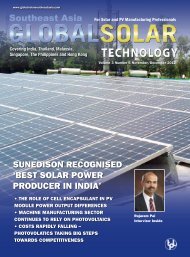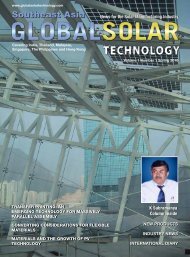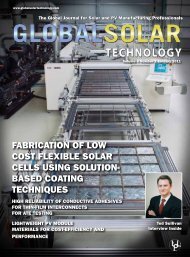download the PDF - Global Solar Technology
download the PDF - Global Solar Technology
download the PDF - Global Solar Technology
- No tags were found...
Create successful ePaper yourself
Turn your PDF publications into a flip-book with our unique Google optimized e-Paper software.
The key to ‘printing’ CIGS: tight tolerance controlBy applying copper indium gallium (di)selenide onto a web of thin foil in aprocess that resembles offset printing, <strong>the</strong>manufacturer can produce CIGS solar cellsthat are much less expensive than siliconwafer cells.chronize multiple axes of <strong>the</strong> rolls in onelong production line. As <strong>the</strong> web moves>100 feet down <strong>the</strong> line through differentprocesses, <strong>the</strong> axes have to align <strong>the</strong> foilmaterial in proper position for <strong>the</strong> nextstep. From step to step, we need tight tolerancecontrol so what happens in one operationlines up with <strong>the</strong> next. If <strong>the</strong> layersdo not match up, <strong>the</strong>n <strong>the</strong> solar cell mustbe scrapped, resulting in wasted materials.Consequently, <strong>the</strong> machinery has to startwith tight tolerances, <strong>the</strong>n maintain it at<strong>the</strong> next step so we don’t have to make a lotof adjustments to <strong>the</strong> web’s tension, speedand position.”In conventional printing, rotary pressesoften use mechanical shafts and gears,but <strong>the</strong>y do not come close to providing<strong>the</strong> accuracy required in this application.Nei<strong>the</strong>r can stepper motors, a solution thatNorthfield Automation Systems has traditionallyemployed in <strong>the</strong>ir web-handlingmachinery.Motion Tech Automation, a local distributorof Bosch Rexroth motion controlproducts, assisted Northfield in finding asuperior alternative—<strong>the</strong> Rexroth SYNAX200 shaftless drive system. With <strong>the</strong>SYNAX 200 system, all <strong>the</strong> machines’ axesare electronically synchronized so when<strong>the</strong> line speed increases or decreases, <strong>the</strong>axes ramp up or down toge<strong>the</strong>r to maintainprecise web position.To maintain accuracy in thousandthsThe modularity inherent in <strong>the</strong> SYNAX 200 system made it possible to develop modular machinedesigns, which simplifies shipping and provides flexibility in configuring <strong>the</strong> line to meetvarious requirements of <strong>the</strong> solar-cell production process.of millimeters along a 100-foot line,Northfield specified Bosch Rexroth’sSYNAX 200 control platform along withIndraDrive intelligent servo drives usingSERCOS III industrial E<strong>the</strong>rnet communication.Designed for <strong>the</strong> web-handling industry,Rexroth’s SYNAX 200 is a control anddrive solution that provides tight control ofweb positions by making minute changesin speed to maintain registration of <strong>the</strong>layers. Instead of mechanical cam shaftsand gears, tightly synchronized digitalservo drives and dynamic servo motorsrun off a standardized control platform tocreate virtual drives, an approach knownas Electronic Line Shafting. The primaryshaft is a virtual master axis. A programmableelectronic gearbox ratio simulates<strong>the</strong> mechanical gearbox between <strong>the</strong>master axis and <strong>the</strong> drive. The master axismaintains a fixed relationship between itsposition and o<strong>the</strong>r virtual slave axes toachieve positioning accuracy that cannotbe obtained with mechanical gearboxes—or even stepper motors.Web handling can be done with steppermotors, however <strong>the</strong> positioning accuracyof stepper motors is between 500 and50,000 steps per revolution. That may seemhigh, but a servomotor using sine/cosineencoders for position monitoring providesover one million counts per revolution.That improves resolution and accuracy byseveral orders of magnitude.The customer was not previouslyfamiliar with Electronic Line Shafting.According to Stotz, “They knew what servomotorswere capable of, but we showed<strong>the</strong>m how one single controller could runall those axes and how <strong>the</strong> architecturecould achieve <strong>the</strong> precision <strong>the</strong>y wanted.”For this application, <strong>the</strong> SYNAX platformincluded a machine vision camerathat focuses on registration marks on<strong>the</strong> web. Position inputs are translated bya PLC that sends instructions to a rackmounted PPC multiaxis controller. Thecontroller communicates with <strong>the</strong> RexrothIndradrive C Converters powering RexrothMSK synchronous servo motors, whichmake <strong>the</strong> appropriate position and speedadjustments as required. Each drive functionsas a stand-alone device with its ownpower supply. Data is transmitted between<strong>the</strong> motion controller and drives in realtime over SERCOS III industrial E<strong>the</strong>rnetthat provides noise immunity.The servomotors adjust speed to varyweb tension—and use speed to vary printlocation. Speed and tension can be adjustedby 1 percent increments as needed.With <strong>the</strong> SYNAX 200, achieving preContinued on page 11www.globalsolartechnology.com<strong>Global</strong> <strong>Solar</strong> <strong>Technology</strong> – June 2011 – 9
















